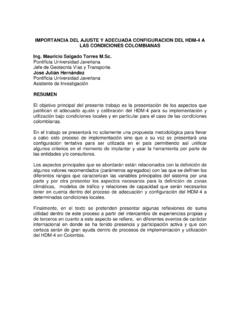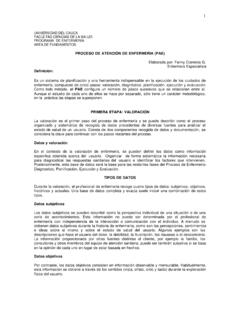Transcription of Statistics for Business and Economics
1 2 Marcelo FernandesStatistics for Business andEconomicsDownload free books at Statistics for Business and Economics 2009 Marcelo Fernandes & Ventus Publishing ApSISBN 978-87-7681-481-6 Download free books at for Business and Economics 4 ContentsContents1. Introduction Gathering Data handling Probability and statistical inference 2. Data description Data distribution Typical values Measures of dispersion 3. Basic principles of probability Set theory From set theory to probability 4. Probability distributions Random variable Random vectors and joint Marginal distributions Conditional density function Independent random Expected value, moments, and co-moments678911111315181819363653565758 60 Please click the advertDownload free books at for Business and Economics Contents5 Discrete distributions Continuous distributions 5.
2 Random sampling Sample Statistics Large-sample theory6. Point and interval estimation Point estimation Interval estimation 7. Hypothesis testing Rejection region for sample means Size, level, and power of a test Interpreting Likelihood-based tests74879599102107108121127131136141142 what s missing in this equation?maeRsK inteRnationaL teChnoLogY & sCienCe PRogRammeYou could be one of our future talentsAre you about to graduate as an engineer or geoscientist? Or have you already graduated?If so, there may be an exciting future for you with Moller - Maersk. click the advertDownload free books at for Business and Economics 6 Chapter 1 IntroductionThis compendium aims at providing a comprehensive overview of the main topics that ap-pear in any well-structured course sequence in Statistics for Business and Economics at theundergraduate and MBA levels.
3 The idea is to supplement either formal or informal statistictextbooks such as, , Basic Statistical Ideas for Managers by Hildebrand and and The Practice of Business Statistics : Using Data for Decisions by Moore, McCabe, Duckworth and Sclove, with a summary of theory as well as witha couple of extra examples. In what follows, we set the road map for this compendium bydescribing the main steps of statistical free books at for Business and Economics 7 Statistics is the science and art of making sense of both quantitative and qualitative thinking now dominates almost every field in science, including social sciences suchas Business , Economics , management, and marketing.
4 It is virtually impossible to avoid dataanalysis if we wish to monitor and improve the quality of products and processes within abusiness organization. This means that economists and managers have to deal almost dailywith data gathering, management, and Gathering dataCollecting data involves two key decisions. The first refers to what to measure. Unfortu-nately, it is not necessarily the case that the easiest-to-measure variable is the most relevantfor the specific problem in hand. The second relates to how to obtain the data. Sometimesgathering data is costless, , a simple matter of internet downloading. However, there aremany situations in which one must take a more active approach and construct a data setfrom gathering normally involves either sampling or experimentation.
5 Albeit the latteris less common in social sciences, one should always have in mind that there is no need for alab to run an experiment. There is pretty of room for experimentation within we are not speaking exclusively about research and development. For instance, we couldenvision a sales competition to test how salespeople react to different levels of performanceincentives. This is just one example of a key driver to improve quality of products is a much more natural approach in social sciences. It is easy to appreciatethat it is sometimes too costly, if not impossible, to gather universal data and hence it makessense to restrict attention to a representative sample of the population.
6 For instance, whilecensus data are available only every 5 or 10 years due to the enormous cost/effort that itinvolves, there are several household and Business surveys at the annual, quarterly, monthly,and sometimes even weekly free books at for Business and Economics 8 Data handlingRaw data are normally not very useful in that we must normally do some data manipulationbefore carrying out any piece of statistical analysis. Summarizing the data is the primarytool for this end. It allows us not only to assess how reliable the data are, but also tounderstand the main features of the data. Accordingly, it is the first step of any sensibledata data is not only about number crunching.
7 Actually, the first task to trans-form numbers into valuable information is invariably to graphically represent the data. Acouple of simple graphs do wonders in describing the most salient features of the data. Forexample, pie charts are essential to answer questions relating to proportions and instance, the riskiness of a portfolio typically depends on how much investment thereis in the risk-free asset relative to the overall investment in risky assets such as those inthe equity, commodities, and bond markets. Similarly, it is paramount to map the sourceof problems resulting in a warranty claim so as to ensure that design and production man-agers focus their improvement efforts on the right components of the product or second step is to find the typical values of the data.
8 It is important to know, forexample, what is the average income of the households in a given residential neighborhood ifyou wish to open a high-end restaurant there. Averages are not sufficient though, for interestmay sometimes lie on atypical values. It is very important to understand the probabilityof rare events in risk management. The insurance industry is much more concerned withextreme (rare) events than with next step is to examine the variation in the data. For instance, one of the maintenets of modern finance relates to the risk-return tradeoff, where we normally gauge theriskiness of a portfolio by looking at how much the returns vary in magnitude relative totheir average value.
9 In quality control, we may improve the process by raising the averageIntroductionDownload free books at 9 quality of the final product as well as by reducing the quality variability. Understandingvariability is also key to any statistical thinking in that it allows us to assess whether thevariation we observe in the data is due to something other than random final step is to assess whether there is any abnormal pattern in the data. For instance,it is interesting to examine nor only whether the data are symmetric around some value butalso how likely it is to observe unusually high values that are relatively distant from the bulkof Probability and statistical inferenceIt is very difficult to get data for the whole population.
10 It is very often the case that it istoo costly to gather a complete data set about a subset of characteristics in a population,either because of economic reasons or because of the computational burden. For instance, itis impossible for a firm that produces millions and millions of nails every day to check eachone of their nails for quality control. This means that, in most instances, we will have toexamine data coming from a sample of the for Business and EconomicsIntroductionAlways aiming for higher another day at the office for a Tiger. 2009 Accenture. All rights the Accenture High Performance Business Forum On Thursday, April 23rd, Accenture invites top students to the High Performance Business Forum where you can learn how leading Danish companies are using the current economic downturn to gain competitive advantages.








